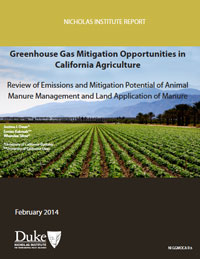Manure management, primarily in anaerobic lagoons on dairies, is estimated to be the largest source of greenhouse gases from California agriculture. However, no field measurements from dairies in California have been published. A review of the broader literature revealed that emissions from anaerobic lagoons had more than 10 times the global warming potential of emissions from solid manure piles. Capping anaerobic lagoons and flaring the emitted methane, or fully converting to anaerobic digesters, could reduce total methane emissions by 92% (~7.7 Tg CO2e). Manure from farms is eventually applied to agricultural fields as fertilizer, where nitrous oxide is the primary greenhouse gas (GHG) emitted. Limited data are available on GHG emissions from manure-amended fields, and only two studies were conducted in California. This research suggested that fertilizing agricultural fields with manure rather than synthetic fertilizers results in lower GHG emissions as well as increased soil carbon storage. Despite the significance of dairy manure in GHG budgets at the state, regional, and global scale, this review reveals a surprising lack of field-scale research necessary to inform the development of best practices in California. Key areas of research for California include measurements of GHG emissions from dairy manure management systems and comparisons of GHG emissions from agricultural fields under different management practices.
Nicholas Institute for Environmental Policy Solutions
Publisher


